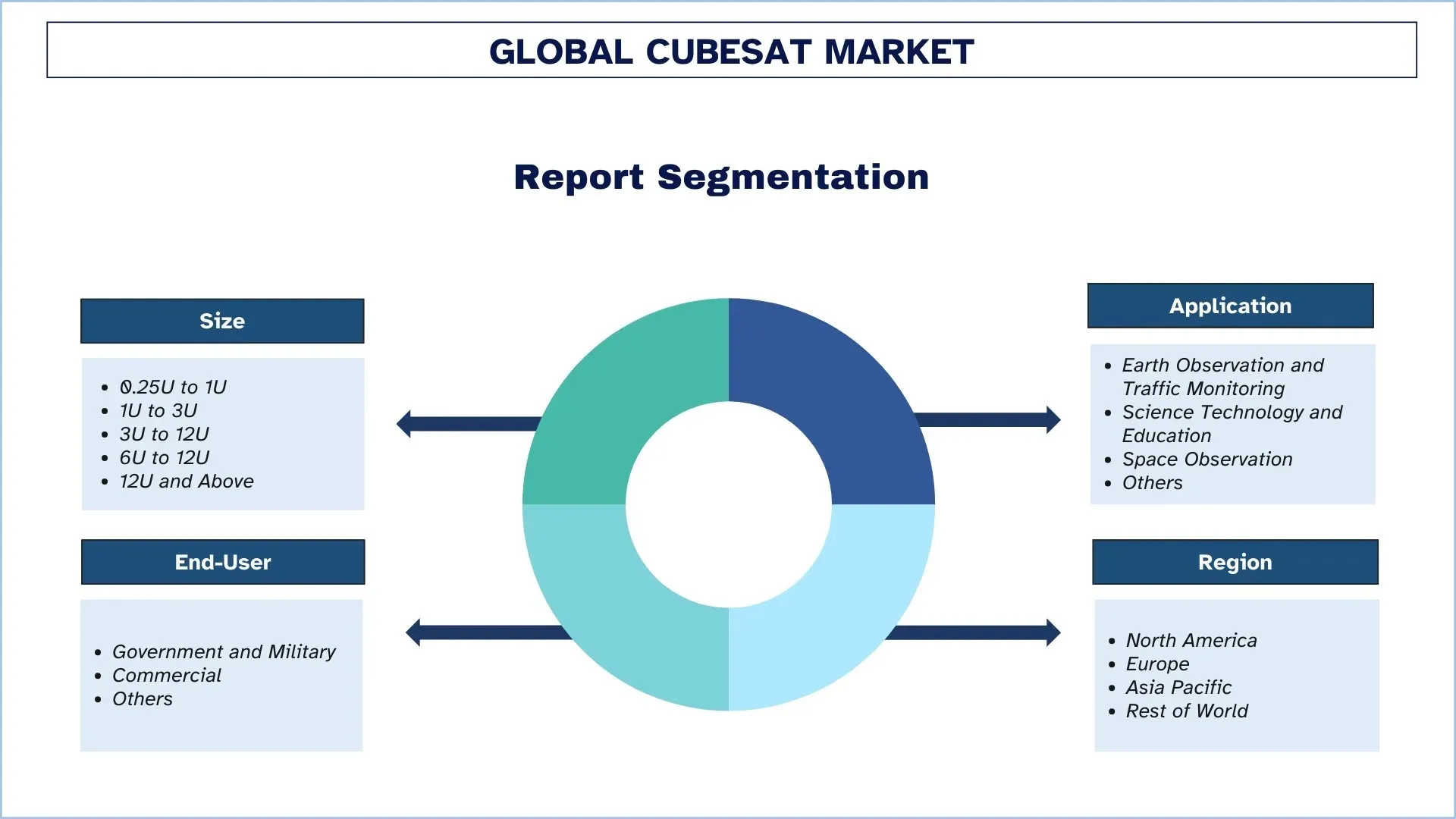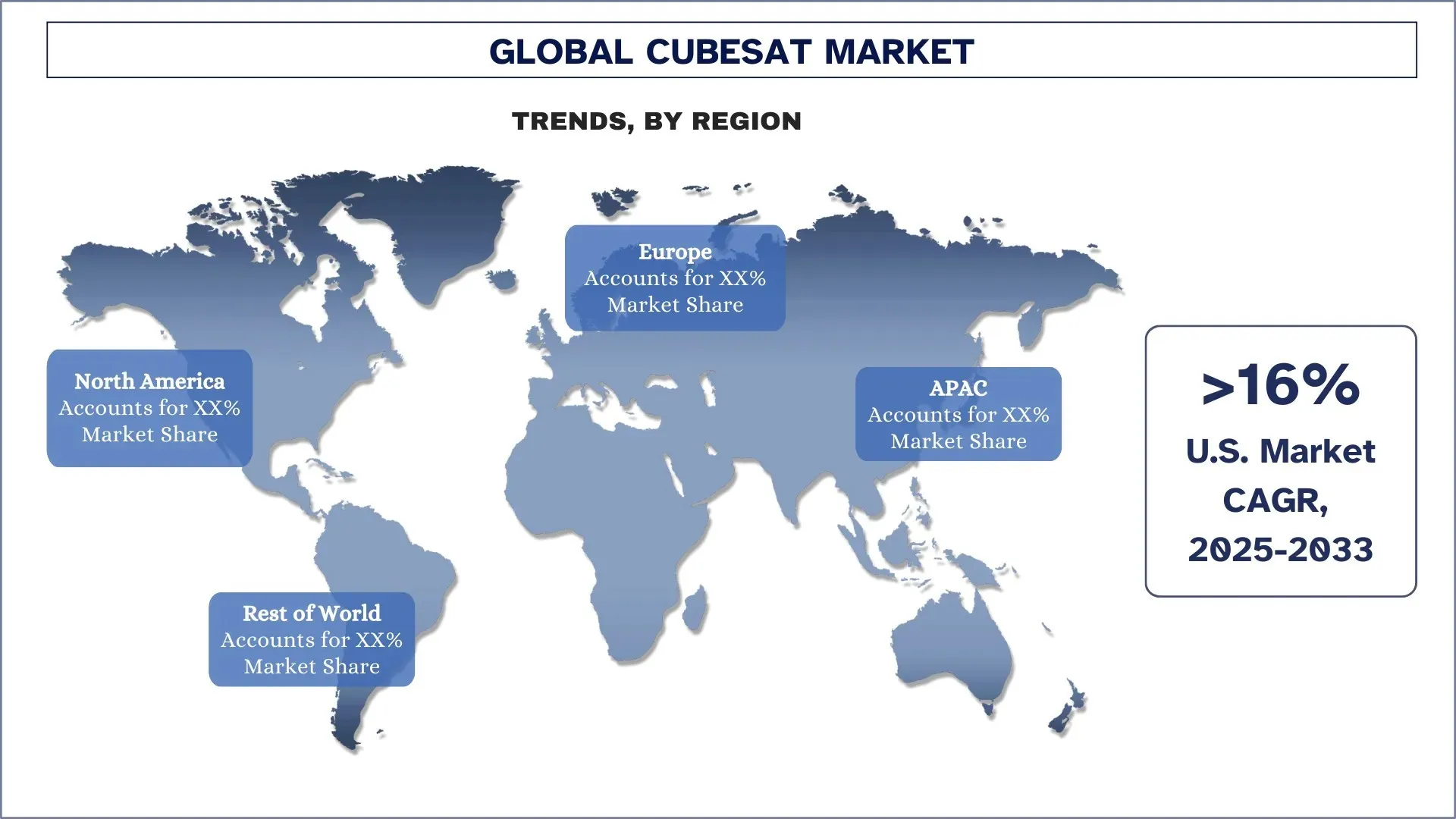- Home
- About Us
- Industry
- Services
- Reading
- Contact Us
CubeSat Market: Current Analysis and Forecast (2025-2033)
Emphasis on Size (0.25U to 1U, 1 to 3U, 3U to 12U, 6U to 12U, and 12U and Above); Application (Earth Observation and Traffic Monitoring, Science Technology and Education, Space Observation, and Others); End-User (Government and Military, Commercial, and Others); and Region/Country

Global CubeSat Market Size & Forecast
The Global CubeSat Market was valued at USD 448.50 million in 2024 and is expected to grow at a CAGR of around 15.38% during the forecast period (2025-2033F), driven by the growing demand for Earth observation & remote sensing, increased access to launch services, and advances in miniaturized technology.
CubeSat Market Analysis
The global space and satellite services market is experiencing a rapid adoption of CubeSats, which have been identified by several organizations as cost-effective, flexible, and technologically competent. CubeSats are much smaller than conventional satellites; they can be fitted with sophisticated systems that enable them to fulfill most of the same capabilities as conventional satellites, including earth observation, communication, and scientific research. These small form factor satellites are also constructed out of a consistent modular component, which enables easier, quicker designing, launching, and scaling specific missions. The increased demand for cheap access to space, and the increased demands of real-time data, cosmopolitan connectivity, and earth observation have been motivators in this innovation. CubeSats allow educational institutions, start-ups, and even countries that are still developing to enter the space economy without making the kind of capital investment that had become traditionally required to launch full-scale satellite missions. The trend of customers requiring high-resolution, time-sensitive data combined with the creation of novel onboard systems, legacy and miniature sensors, AI processors, and propulsion modules has been causing a spike in the increasing use of CubeSats. These systems are now quite capable of doing such complex tasks as monitoring crops, monitoring climatic conditions, managing disasters, and even monitoring global assets. With the aim of democratizing space access and advancing their digital and observational reach, industries and governments globally are rapidly turning towards CubeSats as an instrument of changing the landscape of the global space ecosystem.
Global CubeSat Market Trends
This section discusses the key market trends that are influencing the various segments of the global CubeSat market, as found by our team of research experts.
On‑board AI & Edge Computing
Leveraging on-board AI and edge computing, CubeSats are quickly developing into intelligent and autonomous vehicles, where data collected can be analyzed and decisions can be made in real-time directly in space. This transition will also eliminate the need to downlink entire raw datasets in a downlink scenario. Instead of transmitting raw information as before, satellites are now able to filter, prioritize, and compress only the key information necessary to relay the mission data, significantly reducing bandwidth consumption and latency. An example is the Φ-Sat-2 6U CubeSat launched in August 2024 by ESA, with onboard AI capabilities like cloud detection, ship detection, mapmaker, and deep image compression, based on Intel Movidius VPU and the NanoSat MO framework. More recently, convolutional networks deployed via FPGA acceleration exhibited very efficient FPGA-implemented cloud detection, with performance exceeding 57 FPS and consuming only 2.5 W, indicating that even low-power platforms can be used to run elegant ML models. The trend gives CubeSats the ability to become edge intelligence nodes, which opens the door to quicker revelation in Earth observation, emergency reaction, and independent mission runs.
CubeSat Industry Segmentation
This section provides an analysis of the key trends in each segment of the global CubeSat market report, along with forecasts at the global, regional, and country levels for 2025-2033.
The 1U to 3U Segment Dominates the CubeSat Market
Based on Size, the CubeSat market is segmented into 0.25U to 1U, 1U to 3U, 3U to 12U, 6U to 12U, and 12U and Above. In 2024, the 1U to 3U segment dominated the market and is expected to maintain its lead through the forecast period. This is the sweet spot between cost and capability of performance. A typical 3U can deploy medium-resolution imagers, SDR transceivers, or miniature propulsion systems, and still fit standard P-POD/ESPA rideshare deployers at launch costs of less than USD 300,000 per satellite. Consequently, the universities, start-ups, and defense agencies propose 1-3 U buses in rapid-cycle Earth-observation, technology-demonstration, and experimental communications constellations. Moreover, the expanding application of CubeSats has paved the way for a wider use of the Internet of Things (IoT) across the globe, as space-based communication has enabled connecting parts of the Earth where ground-based communication cannot be established. The world is being characterized by more and more sensor-based machines that demand worldwide communications and links.
The Earth Observation and Traffic Monitoring Category held the Largest Market Share in the CubeSat Market
Based on application, the CubeSat market is segmented into Earth Observation and Traffic Monitoring, Science Technology and Education, Space Observation, and Others. In 2024, the Earth Observation & Traffic Monitoring segment held the biggest share and is set to stay on top for the next few years. The emergence of miniature imaging constellations provides governments and businesses with inexpensive, high-resolution images of agricultural fields, forests, towns, and transportation corridors, and automatic identification broadcasts by vessels and planes. Launch sharing and off-the-shelf satellite components reduce the cost of a mission down to the level of daily, or in some cases, hourly coverage. The onboard processors are small in size and filter raw images before being downlinked, reducing bandwidth requirements and accelerating delivery of the images to the end users. Such benefits maintain the population's interest in the Earth and traffic information, and establish the segment as a leading one. Increasing climate-risk initiatives and smart-city initiatives also promote usage.

North America Dominated the Global CubeSat Market
North America is the biggest market for CubeSats and is likely to command the market in the entire forecast period. One of the key factors of this domination includes the well-established base of aerospace giants, including SpaceX, Lockheed Martin, and Northrop Grumman, and the booming space-tech startup community and academic research organizations. Specifically, the United States has been at the forefront of the region because it has invested heavily in the field of space innovation, has an active CubeSats launch plan, and has implemented cross-cutting of its usage in defense, commercial, and academia. The CubeSat market in North America is characterized by heavy government sponsorship, especially within the NASA CubeSat Launch Initiative (CSLI) program, which sponsors and enables multiple small satellite missions, and the U.S. Department of Defense, which sponsors government small satellite missions. Through these programs, partnerships with universities are created and with private firms in order to hasten the development and deployment of CubeSats. Moreover, North America also has one of the most active commercial launch providers and therefore provides viable rideshare opportunities and access to low orbits at low prices, which is also creating a booming market.
U.S. held a dominant Share of the North America CubeSat Market in 2024
The US has the largest market in the global CubeSat market as it has a strong government backing, a well-developed aerospace economy, and a high investment in space research and the military. A large number of CubeSats are launched by NASA, the U.S. Department of Defense, as well as many universities and commercial enterprises, mostly for Earth observation, communication, and scientific research probes, and also for contingency roles in military situations. The market is further boosted by the presence of already registered players, such as Planet Labs, Spire Global, and Tyvak, as well as the availability of good infrastructure to support satellite manufacturing and launching services. Also, the issues of public-private partnerships and the growing appetite to have real-time data are prompting the development of innovation in payload design and satellite miniaturization. As space exploration and the use of satellite services continue to grow, the U.S. is expected to remain at the forefront, influencing global standards and strategies on CubeSats.

CubeSat Industry Competitive Landscape
The global CubeSat market is competitive, with several global and international market players. The key players are adopting different growth strategies to enhance their market presence, such as partnerships, agreements, collaborations, new product launches, geographical expansions, and mergers and acquisitions.
Top CubeSat Companies
Some of the major players in the market are AAC Clyde Space, CU Aerospace, EnduroSat, GomSpace, ISISPACE GROUP, Pumpkin Space Systems, Space Inventor A/S, Tyvak International, Blue Canyon Technologies LLC, and Konsberg (NanoAvionics).
Recent Developments in the CubeSat Market
In April 2025, KULR Technology Group collaborated with AstroForge to create a bespoke 500Wh KULR ONE Space (K1S) embedded battery system to be equipped in space applications. K1S battery is designed to provide mission-specific performance and high energy density since it has implemented NASA-approved cells and architectures. It also sports the elite Battery Management System of KULR, and it is the third version of the KULR ONESpace design. The partnership enhances KULR in the space battery market, as the space battery market continues to grow to support use in CubeSats and deep-space missions.
In January 2025, NASA launched Technology Education Satellite 22 (TES-22) CubeSat spacecraft to investigate the thermosphere of Earth. The satellite incorporates such major technologies as the deployable Exo-Brake, radiation detector, and solid-state battery test. TES-22 has the intention of shortening the deorbiting and obtaining data on formation drag enhancement and solar impact. It is a mission under the NASA CubeSat Launch Initiative that assists institutions of learning in conducting cost-efficient research in space.
Global CubeSat Market Report Coverage
Details | |
Base year | 2024 |
Forecast period | 2025-2033 |
Growth momentum | Accelerate at a CAGR of 15.38% |
Market size 2024 | USD 448.50 Million |
Regional analysis | North America, Europe, APAC, Rest of the World |
Major contributing region | North America is expected to dominate the market during the forecast period. |
Key countries covered | U.S., Canada, Germany, U.K., Spain, Italy, France, China, Japan, and India |
Companies profiled | AAC Clyde Space, CU Aerospace, EnduroSat, GomSpace, ISISPACE GROUP, Pumpkin Space Systems, Space Inventor A/S, Tyvak International, Blue Canyon Technologies LLC, and Konsberg (NanoAvionics) |
Report Scope | Market Trends, Drivers, and Restraints; Revenue Estimation and Forecast; Segmentation Analysis; Demand and Supply Side Analysis; Competitive Landscape; Company Profiling |
Segments Covered | By Size; By Application; By End-User; By Region/Country |
Reasons to Buy CubeSat Market Report:
The study includes market sizing and forecasting analysis confirmed by authenticated key industry experts.
The report briefly reviews overall industry performance at a glance.
The report covers an in-depth analysis of prominent industry peers, primarily focusing on key business financials, type portfolios, expansion strategies, and recent developments.
Detailed examination of drivers, restraints, key trends, and opportunities prevailing in the industry.
The study comprehensively covers the market across different segments.
Deep dive regional-level analysis of the industry.
Customization Options:
The global CubeSat Market can further be customized as per the requirements or any other market segment. Besides this, UnivDatos understands that you may have your own business needs; hence, feel free to contact us to get a report that completely suits your requirements.
Table of Content
Research Methodology for the Global CubeSat Market Analysis (2023-2033)
We analyzed the historical market, estimated the current market, and forecasted the future market of the global CubeSat market to assess its application in major regions worldwide. We conducted exhaustive secondary research to gather historical market data and estimate the current market size. To validate these insights, we carefully reviewed numerous findings and assumptions. Additionally, we conducted in-depth primary interviews with industry experts across the CubeSat value chain. After validating market figures through these interviews, we used both top-down and bottom-up approaches to forecast the overall market size. We then employed market breakdown and data triangulation methods to estimate and analyze the market size of industry segments and sub-segments.
Market Engineering
We employed the data triangulation technique to finalize the overall market estimation and derive precise statistical numbers for each segment and sub-segment of the global CubeSat market. We split the data into several segments and sub-segments by analyzing various parameters and trends, including size, application, end-user, and regions within the global CubeSat market.
The Main Objective of the Global CubeSat Market Study
The study identifies current and future trends in the global CubeSat market, providing strategic insights for investors. It highlights regional market attractiveness, enabling industry participants to tap into untapped markets and gain a first-mover advantage. Other quantitative goals of the studies include:
Market Size Analysis: Assess the current market size and forecast the market size of the global CubeSat market and its segments in terms of value (USD).
CubeSat Market Segmentation: Segments in the study include areas of size, application, end-user, and regions.
Regulatory Framework & Value Chain Analysis: Examine the regulatory framework, value chain, customer behavior, and competitive landscape of the CubeSat industry.
Regional Analysis: Conduct a detailed regional analysis for key areas such as Asia Pacific, Europe, North America, and the Rest of the World.
Company Profiles & Growth Strategies: Company profiles of the CubeSat market and the growth strategies adopted by the market players to sustain the fast-growing market.
Frequently Asked Questions FAQs
Q1: What is the global CubeSat Market current market size and its growth potential?
The global CubeSat Market was valued at USD 448.50 million in 2024 and is expected to grow at a CAGR of 15.38% during the forecast period (2025-2033).
Q2: Which segment has the largest share of the global CubeSat Market by size?
The 1U to 3U segment dominated the market and is expected to maintain its leading position throughout the forecast period. This is due to advantages associated with their compact size and standardized format, reduced launch costs, and the flexibility to host diverse payloads for academic, commercial, and defense applications.
Q3: What are the driving factors for the growth of the global CubeSat Market?
Growing Demand for Earth Observation & Remote Sensing: CubeSats are increasingly used for real-time environmental monitoring, disaster management, and agricultural analysis, offering cost-effective, high-frequency data for governments, businesses, and research institutions.
Increased Access to Launch Services: Rideshare programs and dedicated small satellite launchers have reduced launch costs and increased frequency, enabling more CubeSat missions and encouraging new entrants in commercial, academic, and defense sectors.
Advances in Miniaturized Technology: Progress in sensors, electronics, and communication systems has enabled potent payloads to fit within CubeSat constraints, making them viable for complex missions previously reserved for larger, costlier satellites.
Q4: What are the emerging technologies and trends in the global CubeSat Market?
On‑board AI & Edge Computing: CubeSats are increasingly equipped with AI and edge computing capabilities to process data directly in space, enabling faster decision-making, reduced data transmission needs, and enhanced mission autonomy.
Hyperspectral & Specialized Earth‑Observation Payloads: Emerging CubeSats now carry hyperspectral and other advanced sensors, allowing for detailed environmental, agricultural, and mineral analysis, previously achievable only with larger satellites, thereby broadening commercial and scientific applications.
Q5: What are the key challenges in the global CubeSat Market?
Limited Power, Payload, and Lifespan: CubeSats face constraints in power generation, payload capacity, and operational life, limiting their ability to perform complex missions or sustain long-term data collection without technical trade-offs.
Space Debris and Regulatory Concerns: The rapid increase in CubeSat deployments raises concerns about space debris and collision risks, prompting stricter international regulations and the need for clear de-orbiting and tracking protocols.
Q6: Which region dominates the global CubeSat Market?
North America is the largest market for CubeSats and is expected to maintain its dominance during the forecast period. The key factors driving regional growth include strong government investments in space programs, a well-established aerospace industry, and the presence of leading CubeSat manufacturers. Additionally, growing commercial demand for Earth observation, communication, and scientific missions, combined with increased launch accessibility, is fueling innovation and market expansion.
Q7: Who are the key players in the global CubeSat Market?
Some of the key companies include:
• AAC Clyde Space
• CU Aerospace
• EnduroSat
• GomSpace
• ISISPACE GROUP
• Pumpkin Space Systems
• Space Inventor A/S
• Tyvak International
• Blue Canyon Technologies LLC
• Konsberg (NanoAvionics)
Q8: What is the current regulatory landscape for the CubeSat market, and how does it impact business operations?
Launch Licensing & Spectrum Allocation: Agencies like the FCC, ITU, and national space authorities require strict licensing and frequency allocation, impacting timelines and compliance costs.
Space Traffic Management: Emerging global efforts to manage orbital congestion are leading to new protocols for tracking, maneuvering, and debris mitigation.
Export Controls: CubeSat components and data services are subject to international export control laws (e.g., ITAR), influencing global partnerships and supplier networks.
Q9: How does the scalability of production affect investment potential in the CubeSat Market?
Standardized Platforms Reduce Risk: Modular, mass-producible CubeSat designs reduce development time and enable repeatable deployment, attracting infrastructure-focused investors.
Constellation Deployment Capability: Scalable manufacturing and launch readiness enable rapid deployment of satellite constellations for broadband, IoT, and Earth observation services.
Higher ROI Potential: Streamlined scaling leads to quicker time-to-market and better unit economics, boosting investment appeal in both upstream (manufacturing) and downstream (data services) segments.
Related Reports
Customers who bought this item also bought










